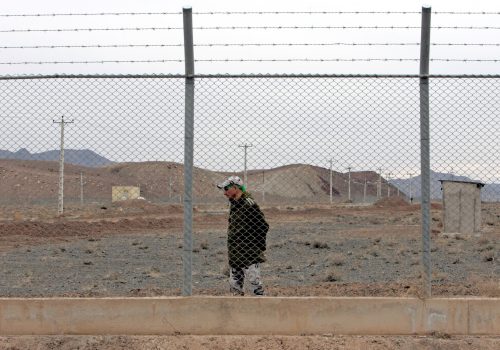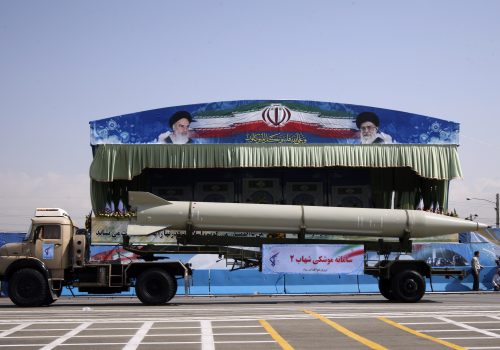Iran-linked missile and maritime threats continue. Here’s how the US and its regional partners can bolster deterrence.
Since the 1980s, US forces, partner states, and regional waterways have been threatened by Iran’s increasingly precise ballistic and cruise missiles and naval forces, all of which put US economic and strategic interests at risk in the Middle East. Recent events—ranging from the January 24 Houthi attack on Al-Dhafra Airbase to the March 13 Iranian attack on an alleged Israeli facility in Erbil, Iraq—suggest that the United States’ deterrence in this manner has been insufficient since at least June 2019, when Iran downed a US unmanned surveillance drone over the Persian Gulf. Therefore, a shift in US strategy is needed to reestablish credible deterrence that denies potential attacks and punishes violations in order for the US and its partners in the Middle East to counter Iranian naval aggression and missile launches.
Challenges to US deterrence against Iran
Deterrence and extended deterrence—discouraging attacks against the US and its partners—are staples of US strategy in the Middle East. In the case of Iranian maritime and missile attacks, however, the challenge of US deterrence is further complicated by the Middle East’s geopolitical context.
US attempts at deterrence by denial—discouraging Iran from launching an attack due to its unlikeliness to hit its target—face several primary challenges. First, simply put, deterring missile and naval attacks by denial is difficult, given a combination of geographic factors and the technological limitations of defenders. Second, US and partner capabilities in the region aren’t currently optimized to confront the primary Iranian threats. Third, US partners lack sufficiently integrated network defense to credibly defend against attacks.
The Persian Gulf is geographically condensed, resulting in short flight times for projectiles fired by Iran-linked forces. Consequently, detecting, tracking, and engaging projectiles with varying flight trajectories—such as ballistic missiles, cruise missiles, and unmanned aerial vehicles (UAV)—is more challenging than in other regions. The proliferation of these projectiles among Iran’s partners in the Gaza Strip, Iraq, Lebanon, Syria, and Yemen increases the number of directions from which an attack might emanate, challenging the ability of the US and its partners to optimally position radars and batteries.
Furthermore, despite decades of investments in missile defense technology, missile defenders remain at a disadvantage in the offense-defense relationship. Additionally, missile interceptors often cost more than offensive projectiles, making missile defense an unsustainable affair from a resource standpoint. In March 2021, Israel used one of its F-35I Adir aircraft—one of the most expensive weapons systems in the world—to intercept an Iranian UAV over an unidentified third country prior to it entering Israeli airspace, illustrating the cost asymmetry associated with countering the Iranian threat.
Deterring Iranian naval forces by denial is similarly challenged by geographic factors. The United States and its partners must maintain maritime domain awareness across the entirety of the Persian Gulf, a vast waterway of global economic importance that facilitates the flow of large volumes of crude oil and liquified natural gas. Here, Iran is capable of using fast boats to seize vessels and a variety of sea mines to quickly close access via the Strait of Hormuz—which 20 percent of the world’s oil passes through—as self-detrimental as that may be.
Deterring Iran by denial is further complicated by US and partner capabilities, which aren’t aligned. The Gulf Arab states lack meaningful missile defense and naval capabilities, meaning that the United States plays an outsized role in their security. The United States too often attempts to deter with the presence of a carrier strike group, an asset that, for all its might, is ill-suited to confront Iran’s asymmetric tactics.
A region as condensed as the Middle East requires tight partner coordination to manage responses to potential Iranian provocations against both US and partner forces. Missile defenders and naval patrols alike should be synchronized in their engagements, as well as on collective self-defense agreements for the eventuality that one partner comes under attack. Maritime security operations that include vessels from various partner states are strengthened when there is clarity about the support that each contributor can expect from others in the event of an attack. Without these predetermined understandings, Iran could more easily fracture US-led coalitions.
Coordination on missile defense is similarly crucial, as a missile may fly over or near one state on its way to another. Predetermined agreements on how inbound projectiles are detected and who is responsible for shooting them down are beneficial. A broad, regional, and integrated missile defense network agreement could be challenging given the differing approaches to Iran taken by the US and states in the region. While the United States has pursued a maximum pressure campaign to counter Iran in recent years, some partners have taken softer approaches. Qatar, home to the largest US military base in the Gulf, made a mockery of further regional integration when, in March, it hosted Iran’s Islamic Revolutionary Guard Corps (IRGC) to display models of the IRGC’s missiles at the Doha International Maritime Defense Exhibition.
If the aforementioned hurdles stem largely from questions about capabilities and coordination, the challenges to deterring Iran by punishment stem overwhelmingly from questions of will. Iran understands that there is little US appetite for another war in the region and the United States is rebalancing to the Indo-Pacific. This stated shift telegraphed Washington’s desire to downgrade its presence in the Middle East. As a result, the United States has avoided direct armed conflict with Iran bar a few exceptions and constrained itself to non-kinetic levers, such as economic sanctions. Because Iran isn’t the least bit scared of US regional threats to escalate conflict, the US ability to deter Iran by punishment is currently weak.
Effectiveness of US deterrence
The US has been able to largely deter direct attacks against US forces by making it clear that Iran will pay a heavy price for killing an American. When Iran killed an American contractor in an attack on an Iraqi military base in 2019, the United States responded emphatically with a drone strike that killed Iran’s most powerful military commander, General Qasem Soleimani. Though Iran responded with a missile strike on a US base in Iraq that resulted in brain injuries to more than one hundred troops, Tehran provided a warning to the Iraqi government and appears to have carefully calibrated the strike to avoid killing US personnel. Some argue that Iran isn’t done avenging the killing of its top general and may retaliate in time. However, the Soleimani strike was a clear message to Iran that reestablished escalation dominance and deterrence against direct attacks.
Nevertheless, numerous instances since the assassination indicate that the US has been ineffective in deterring attacks by Iranian partners and proxies against US forces, in addition to providing extended deterrence. For instance, on January 24, Iran-backed Houthi rebels launched two ballistic missiles from Yemen that, were it not for Patriot missile interceptions, would have struck US forces at Al-Dhafra Airbase in the United Arab Emirates (UAE). Similarly, a recent wave of Houthi missile and UAV attacks against US partners in the Gulf have inflicted serious damages against sites of economic value, such as an oil facility in Jeddah, Saudi Arabia on March 25.
Bolstering US deterrence
To bolster US deterrence, the United States should adopt a multilateral strategy of advancement, reorientation, integration, and domination (ARID).
Given the inherent geographic and technological challenges for both missile and maritime defenders, the United States should focus on developing more sustainable solutions, as well as supporting its partners in their development efforts to shift offense-defense dynamics in their favor.
For example, in February, Israeli Prime Minister Naftali Bennett announced that the Iron Beam directed-energy system would roll out within a year. The system will be capable of intercepting short-range missiles, rockets, and UAVs that fly within its seven-kilometer range with an electric pulse rather than an expensive missile—theoretically neutralizing one of Iran’s most important weapons. Advanced systems like this should be shared with the Gulf Arab states to create a network effect that is critical for missile defense.
Israel has already declared its willingness to share its advanced homegrown missile defense technology with partners like the UAE. This puts aside Israel’s concerns about losing its qualitative military edge, given the defensive nature of the technologies and warming relations with the Gulf states.
Similarly, the United States should prioritize systems like unmanned surface vehicles for maritime security. The US should also push to accelerate the development of advanced systems like these and roll them out across its network of Gulf Arab state partners.
Additionally, the United States should reorient its assistance from providing what are perceived as flashier capabilities to providing those more equipped to deal with Iran’s asymmetric approach. For instance, the US has provided fighter aircraft to regional partners, but these serve little purpose in providing a cost-effective solution to Iran-linked missile and maritime threats. Instead, the United States should reallocate military assistance toward naval capabilities like anti-mine warfare vessels, frigates, and corvettes, as well as the human capital development necessary to operate these systems. This resource reorientation will also allow partners to take more ownership over their security and bolster extended deterrence by denial.
The United States has made progress on partner integration in recent years, as highlighted by the Abraham Accords, which have resulted in significant open-security cooperation. The United States should continue facilitating efforts, like Israel’s proposed regional air defense network, to build trust among partners. While an integrated missile defense network faces various political and practical obstacles, the United States can start small by encouraging the integration of a portion of the Gulf states that possess relatively greater cohesion among themselves—such as Bahrain, Saudi Arabia, and the UAE—and gradually expand as political circumstances allow. The US can also build on recent maritime security efforts, such as the International Maritime Security Construct—created in the aftermath of various Iran-sponsored attacks, as a coalition of states to maintain security in the Gulf (to benefit from partner capabilities like intelligence, surveillance, and reconnaissance).
The United States and its partners face no shortage of challenges in their efforts to deter Iran-linked attacks, particularly from missile and maritime forces. However, the United States can take tangible steps to strengthen deterrence, including advancing capabilities, reorienting assistance, integrating partners, and signaling a willingness to dominate militarily. In so doing, the United States can curb Iranian aggression and protect US interests in the Middle East.
Simon Handler is a nonresident fellow with the Atlantic Council. Follow him on Twitter @SimonPHandler.
Further reading
Mon, Dec 20, 2021
I once headed the Iran branch of Israel’s military intelligence research. Here’s why Israel can’t take out Iran’s nuclear program.
IranSource By
Besides the operational challenges in executing such a military attack, especially given Iranian forces’ buildup of surface-to-air units, there are other more strategic challenges facing Israel.
Thu, Nov 18, 2021
Iran’s drones are clones. Now they’re being used in multiple conflicts.
IranSource By
Iran’s military drone program has grown in recent years and Iran-backed groups have increasingly used drones in conflicts.
Tue, Jun 9, 2020
Post-embargo, Iran arms purchases would be limited and selective
IranSource By Barbara Slavin
Iran's purchases will likely be limited, by both economic and geopolitical constraints, including the impact of US sanctions and the coronavirus pandemic and caution on the part of potential suppliers.
Image: A soldier stands near an Iranian missile during a rally marking the annual Quds Day, or Jerusalem Day, on the last Friday of the holy month of Ramadan in Tehran, Iran April 29, 2022. Majid Asgaripour/WANA (West Asia News Agency) via REUTERS


